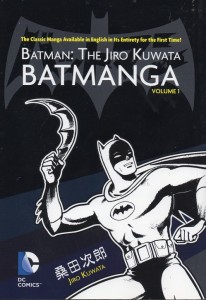Manga Review: Batman: the Jiro Kuwata Batmanga by Jiro Kuwata
In the mid-1960s, the Batman TV show was a huge hit not just in America, but also in Japan. As a tie-in, 8-Man creator Jiro Kuwata was hired to create a manga version of Batman for the local market. While the television show was more based on the late 1950s comic books, the research materials Mr. Kuwata were given were from the “New Look” period, which discarded many of the sillier elements that had been layered onto the franchise over the previous decade to make the Batman comic books as serious as you could expect in the Silver Age.
Thus, this manga has relatively little humor, focusing on Batman as a scientifically-trained detective. Robin is a bit irreverent, but not nearly as much of a wise-cracker as he was in the American comics. The serialized weekly format also changes the structure of the stories, which is more obvious in the plots that are lifted directly from the U.S. version.
The first story is an adaptation of the appearance of very minor villain Death-Man. For the manga version, his name was changed to Shinigamijin which would be literally translated back into English as “Death God Man”, so it’s rendered as “Lord Death-Man” instead. The villain’s gimmick is that each time he’s captured, he dies, then comes back to life and commits more crimes. This freaks Batman the heck out until he finally figures out the trick, and Lord Death-Man meets his final fate.
Oddly, there’s an appearance by a Flash villain, the Weather Wizard, renamed Go Go the Magician. This story demonstrates Batman’s skill at “prep time” setting up a plan to deal with Go Go’s weather control powers which would normally make the villain hard for a normal human to defeat.
The final storyline in this volume, “The Man Who Quit Being Human”, showcases how adaptation changes stories. Both versions feature the governor of whatever state it is that Gotham City is in discovering that he has a gene that allows for mutation. He agrees to undergo an experimental process to stimulate this gene to see what mutants will be like, so that if more show up, humanity will be ready. Unfortunately, it turns out that mutants are insanely powerful, implacably hostile to normal humans and will attempt to destroy humanity. Batman is regretfully forced to destroy the mutant (his code vs. killing does not apply to non-humans.)
The Japanese version gives the governor a daughter who also has the mutant gene. The scientific community debates what to do about this, and the consensus is that she, and by extension anyone else with the mutant gene, must be preemptively executed to prevent further evil mutants. Can our heroes find a way to spare her? This raises the stakes nicely.
The art is very 60s manga, and might take some getting used to for those used to modern art styles. There are a few pages where Mr. Kuwata obviously took a lot more time for detailed renderings; these are particularly effective.
This volume is recommended for Batman fans, and fans of 1960s superheroes in general. Note that some of this material has been previously been printed in a coffee-table sized book, which has a lot of extra information about the series and is highly recommended.

